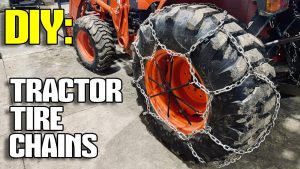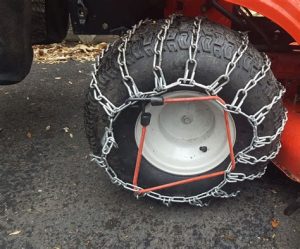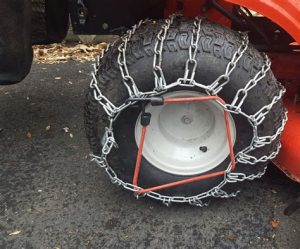Discover the benefits of tractor tire chains, how to choose the right ones, installation tools, and their impact on tractor performance.Winter weather can present significant challenges for farmers and heavy equipment operators, particularly when it comes to maintaining traction on icy or snowy surfaces. Installing tractor tire chains is a practical solution that not only enhances grip but also improves safety and efficiency during the colder months. In this blog post, we will address some frequently asked questions surrounding tractor tire chains, from understanding what they are and their benefits to choosing the right type and the tools required for installation. We’ll also explore whether these chains impact tractor performance. Whether you’re a seasoned farmer or a newcomer to the world of agriculture, this guide will provide you with essential knowledge to navigate winter terrain effectively. Let’s dive in!
What are tractor tire chains?
Tractor tire chains are a specialized accessory designed to improve traction for heavy machinery, particularly when navigating through challenging conditions such as snow, ice, or mud. Constructed from durable metal links, these chains wrap around the tires, providing additional grip on slippery surfaces.
These chains come in various styles and sizes to accommodate different types of tractor tires. Common types include ladder-style chains, which offer excellent traction, and diamond-pattern chains, known for better flexibility and less vibration. With the right choice of chains, you can enhance both the safety and performance of your tractor.
Using tire chains can significantly affect the efficiency of your operations, especially in rural or agricultural settings where the terrain can be unpredictable. They allow tractors to maintain better control, reduce the risk of sliding, and enable reliable operation in adverse weather conditions.
Why should I install tire chains?
Installing tire chains on your tractor can significantly enhance performance and safety, especially during challenging weather conditions.
- Improved Traction: Tire chains provide superior grip on slippery surfaces, which is essential for operations in snow, mud, or icy conditions.
- Increased Stability: By enhancing traction, chains help maintain stability while operating on uneven or challenging terrains.
- Reduced Slippage: Chains minimize the chances of your tractor slipping, hence improving not just productivity but also safety during operations.
Additionally, using tire chains can extend the life of your tractor tires. The chains can reduce wear and tear by providing added support and preventing excessive tread degeneration during tough maneuvers.
Furthermore, when considering the economic factors, investing in tire chains can prevent costly accidents and delays caused by getting stuck. Thus, maintaining a steady workflow becomes much easier.
Overall, tire chains can be a wise investment for enhancing your tractor’s performance and ensuring safety, making your agricultural or landscaping tasks more manageable.
How do I choose the right chains?
Choosing the right tractor tire chains involves considering several factors to ensure optimal performance and safety.
- Compatibility: Ensure that the chains you select are compatible with the specific type and size of your tractor tires. Check the tire dimensions (width, height, and rim size) before making a purchase.
- Material: The material of the chains greatly affects durability and performance. Chains made from hardened steel or alloy steel tend to provide better traction and resistance to wear.
- Link Type: There are various types of links such as diamond, square, and ladder. Each type offers different traction properties. Diamond links, for example, are preferred for achieving optimal grip on icy surfaces.
Additional factors to consider may include the specific terrain you’ll be working on, the weight of your tractor, and how frequently you plan to use the chains. Weighing these elements appropriately can lead to a more informed decision when purchasing tire chains.
Furthermore, you might also want to consider user reviews and expert recommendations. These insights can often provide real-world perspectives on the performance and usability of various types of chains.
Finally, if you’re still uncertain, don’t hesitate to consult with a local dealer or tire specialist. They can provide tailored advice based on your unique needs and local conditions.
What tools do I need for installation?
Installing tractor tire chains can seem daunting, but having the right tools can make the process smoother and more efficient.
| Tool | Purpose |
|---|---|
| Chain Tensioner | To keep the chains taut around the tire. |
| Wrench | To tighten or loosen any connecting links. |
| Ratchet Strap | To secure the chains during transit if necessary. |
| Gloves | To protect your hands from sharp edges. |
| Safety Glasses | To shield your eyes while working. |
In addition to these tools, you may also find a flashlight or portable light source helpful if you are working in a low-light environment. Having a good clear space to work on will also make the process easier.
Remember, a little preparation goes a long way. Having all your tools organized and within reach can help ensure that the installation process goes as smoothly as possible.
Using the right tools will not only aid in the installation of your tire chains but also help ensure they are fitted correctly, enhancing their performance and longevity.
Do tire chains affect tractor performance?
Installing tire chains on your tractor can significantly influence its overall performance. Generally, tire chains are designed to enhance traction, especially in wintry or slippery conditions, which directly affects how well your tractor can operate under challenging circumstances.
When tire chains are installed, they provide additional gripping power on icy or snowy surfaces. This can translate to better *acceleration*, *braking*, and *steering control*, allowing you to carry out your tasks more effectively. The added traction can also mean fewer instances of the tractor getting stuck, which can be a significant time-saver during the busy farming season.
However, it is essential to note that while tire chains improve traction, they can also create more wear and tear on your tires and can sometimes lead to slightly decreased fuel efficiency, depending on the conditions of the ground you’re working on. It’s crucial to balance the benefits of improved traction with potential downsides to tire longevity and fuel usage.
Frequently Asked Questions
What are tractor tire chains used for?
Tractor tire chains are primarily used to enhance traction on slippery surfaces such as mud, snow, and ice, making it easier to operate agricultural equipment under challenging conditions.
How do I determine the correct size of tire chains for my tractor?
To find the right size of tire chains, refer to your tractor’s tire specifications, which are usually found on the sidewall of the tire. Match these specifications with the size listed for the chains.
What is the best way to install tractor tire chains?
Start by laying the chains flat on the ground before your tire. Drive onto the chains so they fit snugly against the tire. Then, pull the ends of the chains up and adjust as necessary, securing them with the provided fasteners.
Can I leave tire chains on my tractor all year round?
It is not advisable to leave tire chains on throughout the year, as they can cause excessive wear on the tires and increase fuel consumption. Remove them when not needed, especially on dry surfaces.
How often should I check the chains for wear and tear?
It’s recommended to inspect tire chains before each use, particularly if they have seen extensive use. Look for signs of wear, damage, or rust, and replace them if necessary.
Are there different types of tractor tire chains available?
Yes, there are various types of tractor tire chains, including link type, ladder type, and diamond pattern. The choice depends on the specific traction needs and the type of surface you’ll be working on.
What precautions should I take when using tire chains?
Always ensure the chains are properly fitted and secured on the tires. Avoid high speeds while driving with chains, and be cautious when turning to prevent damage to both the chains and the tractor.





